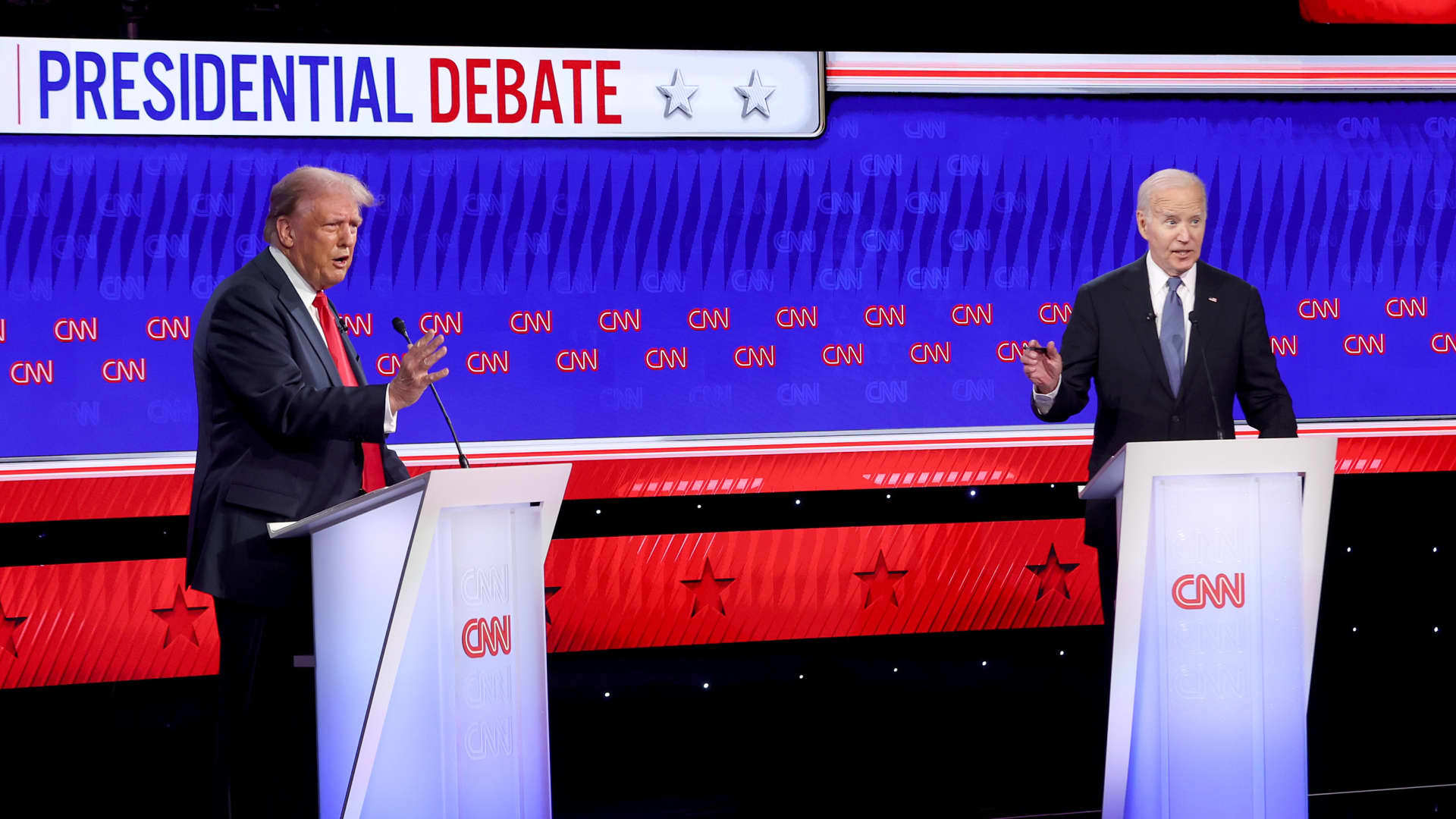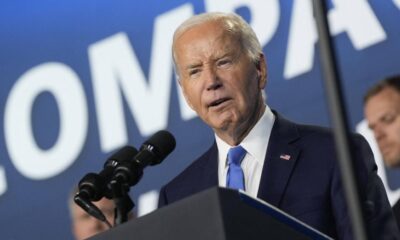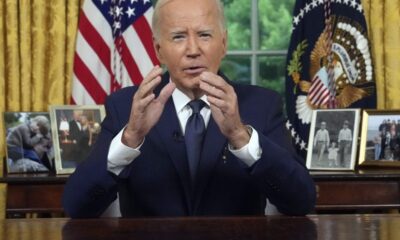Finance
High inflation is largely not Biden or Trump’s fault, economists say

President Joe Biden and former President Donald Trump participate in the CNN presidential debate on June 27, 2024 in Atlanta.
Justin Sullivan | Getty Images News | Getty Images
Inflation slowed again in June, further relieving consumer wallets.
The consumer price index rose 3% in June 2024 from June 2023, compared with annual inflation of 3.3% in May, according to the Bureau of Labor Statistics reported Thursday.
While inflation has not yet fully returned to policymakers’ long-term target of around 2%, it has cooled significantly from around 9% two years ago, the highest level since 1981.
But why did inflation initially increase?
During the first US presidential debate last month, both candidates – President Joe Biden and former President Donald Trump – blamed each other for inflation-related grievances during the pandemic era.
More from Personal Finance:
Here is the inflation breakdown for June 2024 – in one graph
Why housing inflation is still stubbornly high
More and more Americans are struggling, even as inflation cools
“He caused inflation,” Trump said said from Biden during the June 27 debate. “I gave him a country with, essentially, no inflation,” he added.
Biden responded by saying that inflation was low during Trump’s term because the economy was “on its back.”
“He has decimated the economy, absolutely decimated it,” Biden said.
But the cause of inflation is not so black and white, economists say.
In fact, Biden and Trump are not responsible for much of the inflation consumers have experienced in recent years, they said.
‘Neither Trump nor Biden is guilty’
Global events beyond Trump or Biden’s control have wreaked havoc on supply-demand dynamics in the U.S. economy, fueling higher prices, economists said.
There were other factors too.
The Federal Reserve, which operates independently of the Oval Office, moved slowly to rein in hot inflation, for example. Some of Biden and Trump’s policies, such as pandemic relief packages, also likely played a role, as did so-called greed inflation.
“I don’t think this is a simple yes/no answer,” said David Wessel, director of the Hutchins Center on Fiscal and Monetary Policy at the Brookings Institution, a left-leaning think tank.
“Generally speaking, presidents get more credit and blame for the economy than they deserve,” he said.
That Biden is seen as a driver of high inflation is somewhat down to optics: He took office in early 2021, around the time inflation spiked significantly, economists said.
Similarly, the Covid-19 pandemic plunged the US into a severe recession during Trump’s term, sending the consumer price index to almost zero in the spring of 2020, when unemployment soared and consumers cut back on spending.
“In my view, neither Trump nor Biden are responsible for high inflation,” said Mark Zandi, chief economist at Moody’s Analytics. “The pandemic and Russia’s war in Ukraine are to blame.”
The main reasons why inflation rose
A terminal at Qingdao Port on June 20, 2022 in Qingdao, Shandong Province, China.
Wu Shaoyang/VCG via Getty Images
Inflation has many tentacles. At high levels, hot inflation is largely a matter of mismatched supply and demand.
The pandemic has upended the typical dynamic. First, it has disrupted global supply chains.
There was a labor shortage: illness sidelined workers. Childcare centers closed, making it difficult for parents to work. Others were afraid they would get sick while at work. A decline in immigration also reduced the supply of labor, economists said.
China closed factories and cargo ships could not be unloaded in ports, for example, which reduces the supply of goods.
Meanwhile, consumers changed their purchasing behavior.
They bought more physical items, like living room furniture and desks for their home offices, as they spent more time indoors — a departure from pre-pandemic norms, when Americans tended to spend more money on services such as eating out, traveling and going to movies and concerts.
High demand, which soared as the U.S. economy largely reopened, combined with goods shortages to push up prices.

There were other related factors as well.
For example, automakers didn’t have enough semiconductor chips needed to build cars, while car rental companies sold their fleets because they thought the recession wouldn’t be short-lived, making it more expensive to rent as the economy quickly recovered, Wessel says. said.
As Covid cases hit record highs in 2022 and further disrupted supply chains, Russia’s war in Ukraine has “driven” inflation by fueling higher prices for commodities such as oil and food around the world, Zandi said.
As a result, global inflation reached levels “higher than seen in decades,” the International Monetary Fund wrote in October 2022.
‘We only have to look at the still high inflation rates in most other advanced economies to see that most of this period of inflation has actually been about global trends… rather than about the specific policy actions of any given government (although they of course they did). play a role),’ Stephen Brown, deputy chief economist for North America at Capital Economics, wrote in an email.
Impact of large expenditures ‘is only clear afterwards’
U.S. President Joe Biden speaks during remarks on the implementation of the American Rescue Plan in Washington on March 15, 2021.
Eric Baradat | Episode | Getty Images
However, Biden and Trump are not entirely without faults: For example, they have greenlighted additional government spending in the pandemic era that has contributed to inflation, economists said.
For example, the American Rescue Plan — the $1.9 trillion stimulus package that Biden signed in March 2021 — provided $1,400 stimulus checks, enhanced unemployment benefits and an expanded child tax credit for households, among other relief.
The policy led to “some good things,” such as a strong labor market and low unemployment, said Michael Strain, director of economic policy studies at the American Enterprise Institute, a right-wing think tank.
But its size was bigger than the U.S. economy needed at the time, and served to raise prices by putting more money in consumers’ pockets, fueling demand, he said.
“I think President Biden bears some responsibility for the inflation that we’ve had in recent years,” Strain said.
He assessed the American Rescue Plan added about 2 percentage points to underlying inflation. The consumer price index peaked at 9.1% in June 2022, the highest level since 1981. Since then, the index has fallen to 3%.
The Federal Reserve – the US central bank – aims for long-term inflation of around 2%.
“I think if it weren’t for the American Rescue Plan, the U.S. would still have inflation,” Strain added. “So I think it’s important not to overstate the situation.”
Zandi, however, viewed the ARP’s inflation impact as “good” and “desirable,” returning the economy to the Fed’s long-term target after a prolonged period of below-average inflation.
Trump had also approved two stimulus packages worth about $3 trillion in March and December 2020.

These so-called fiscal policy responses were an insurance policy against a poor economic recovery, which may have been overshot after the lackluster US response to the Great Recession, which left the country in high unemployment for years, Wessel said.
That the US may have overstimulated was the fault of the presidents, but “was only clear in retrospect,” he said.
Biden and Trump have also pursued other policies that could contribute to higher prices, economists said.
Trump, for example imposed rates on imported steel, aluminum and various goods from China, which Biden kept largely intact. Biden also imposed new import taxes on Chinese goods such as electric vehicles and solar panels.
The Fed and ‘greed inflation’
U.S. Federal Reserve Chairman Jerome Powell speaks at a news conference on interest rates, the economy and monetary policy measures on June 15, 2022.
Olivier Douliery- | Episode | Getty Images
Fed officials also bear some responsibility for inflation, economists said.
The central bank uses interest rates to control inflation. Raising interest rates increases financing costs for companies and consumers, cooling the economy and thus inflation.
The Fed raised interest rates to the highest level in about two decades but initially acted slowly, economists said. They were first increased in March 2022, about a year after inflation started to rise.
It also waited too long to roll back “quantitative easing,” Strain said, a bond-buying program aimed at boosting economic activity.
“That was a mistake,” Zandi said of the Fed’s policy. “I don’t think anyone would have done it right given the circumstances, but in retrospect it was a mistake.”
Some observers have also pointed to so-called greed inflation – the idea that companies take advantage of the high inflation narrative to raise prices more than necessary and thus boost profits – as a contributing factor.
This is unlikely to have been a cause of inflation, although it may have been a small contributor, economists said.
“To the extent that something like that were to happen — and I’m not sure it did — it would be a very minor factor in the inflation that we had,” Strain said. He estimates that the dynamic would have added well less than 1 percentage point to inflation.
“Companies are always looking for an opportunity to raise prices when they can,” Wessel said. “I think they benefited from the inflationary environment, but I don’t think they caused it.”













